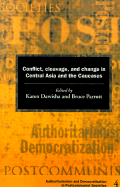Book contents
- Frontmatter
- Contents
- List of tables
- List of contributors
- Preface
- 1 Perspectives on postcommunist democratization
- 2 Democratization and political participation: research concepts and methodologies
- The Caucasus
- Central Asia
- 6 Democratization and the growth of political participation in Kazakstan
- 7 Kyrgyzstan: the fate of political liberalization
- 8 Thwarted democratization in Tajikistan
- 9 Turkmenistan: the quest for stability and control
- 10 Political development in Uzbekistan: democratization?
- Appendix
- Index
9 - Turkmenistan: the quest for stability and control
Published online by Cambridge University Press: 01 June 2011
- Frontmatter
- Contents
- List of tables
- List of contributors
- Preface
- 1 Perspectives on postcommunist democratization
- 2 Democratization and political participation: research concepts and methodologies
- The Caucasus
- Central Asia
- 6 Democratization and the growth of political participation in Kazakstan
- 7 Kyrgyzstan: the fate of political liberalization
- 8 Thwarted democratization in Tajikistan
- 9 Turkmenistan: the quest for stability and control
- 10 Political development in Uzbekistan: democratization?
- Appendix
- Index
Summary
Introduction
The basis of comparison for measuring developments in the Newly Independent States is the pre-Gorbachev (1985) Soviet Union. Domestically, that political system featured top-down rule by the Communist Party, which enjoyed constitutionally mandated monopoly status, strict party control of all branches of government and the mass media, ubiquitous intelligence apparati, generalized non-observance of human rights, as well as surveillance and repression of human rights activists and organizations. Ideologically, the state propagated and enforced Marxism-Leninism, and explicitly identified itself with that doctrine. The economy was planned, with institutionalized shortages of consumer goods, and the criminalization of most private, profit-oriented economic activity. Also characteristic of Soviet reality before 1985 was “police-state peace and quiet,” that is, relative security and safety from crime, and the absence of open ethnic conflict, let alone large-scale bloodshed and waves of refugees.
Reform, broadly speaking, therefore encompasses decentralization (of institutions of governance and decision-making), democratization (opening the political process by permitting pluralism and instituting fair elections, ending censorship, allowing freedom of speech, association and assembly, and letting non-governmental organizations influence policy), as well as market-oriented economic change. By that standard, Turkmenistan has changed since gaining independence, but is probably the least transformed former Soviet republic. The lack of reform is neither accidental nor due to uncontrollable circumstances; rather, it reflects a deliberate decision by the country's ruling elite to eschew policies initiated in Russia and the other Newly Independent States which, in the regime's view, have generated, or exacerbated, economic hardship, political conflict, civil unrest, ethnic tension, and in some cases, have led to ethnic warfare.
- Type
- Chapter
- Information
- Conflict, Cleavage, and Change in Central Asia and the Caucasus , pp. 312 - 359Publisher: Cambridge University PressPrint publication year: 1997
- 12
- Cited by



